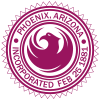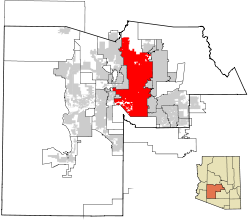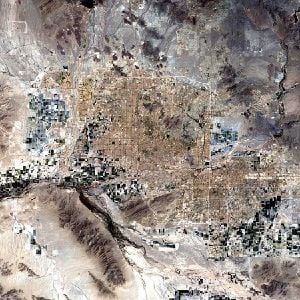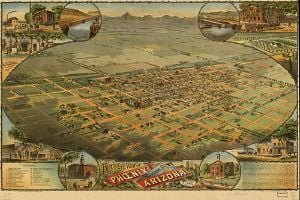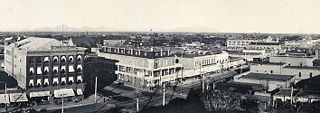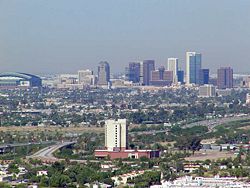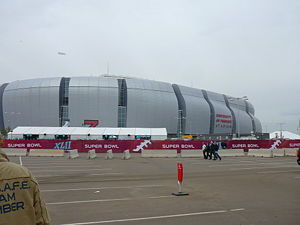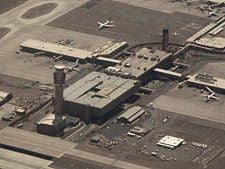Difference between revisions of "Phoenix, Arizona" - New World Encyclopedia
Vicki Phelps (talk | contribs) m |
Mary Anglin (talk | contribs) (ref format) |
||
| Line 237: | Line 237: | ||
Phoenix is served by a growing network of freeways, many of which were initiated by a ½ cent general sales tax measure approved by voters in 1985. Before this network, Interstate 10 and Interstate 17 handled almost all freeway traffic in Phoenix, placing a large burden on surface arterial streets, leading to increased traffic congestion as the area grew in size. | Phoenix is served by a growing network of freeways, many of which were initiated by a ½ cent general sales tax measure approved by voters in 1985. Before this network, Interstate 10 and Interstate 17 handled almost all freeway traffic in Phoenix, placing a large burden on surface arterial streets, leading to increased traffic congestion as the area grew in size. | ||
| + | |||
| + | ==Notes== | ||
| + | <references/> | ||
==References== | ==References== | ||
| − | + | *Abbott, David R. 2000. ''Ceramics and community organization among the Hohokam''. Tucson: University of Arizona Press. ISBN 9780816519361 | |
| + | *Chavez, Cesar, Richard J. Jensen, and John C. Hammerback. 2002. ''The words of César Chávez''. College Station: Texas A & M University Press. ISBN 9781585449620 | ||
| + | *Logan, Michael F. 2006. ''Desert cities: the environmental history of Phoenix and Tucson''. History of the urban environment. Pittsburgh, Pa: University of Pittsburgh Press. ISBN 9780822942948 | ||
==External links== | ==External links== | ||
| − | + | All Links Retrieved November 19, 2008. | |
| − | *[http://www.phoenix.gov | + | *[http://www.phoenix.gov City of Phoenix Website] |
*[http://www.phoenixchamber.com/ Greater Phoenix Chamber of Commerce] | *[http://www.phoenixchamber.com/ Greater Phoenix Chamber of Commerce] | ||
*[http://www.phoenixcvb.com/ Greater Phoenix Convention & Visitors Bureau] | *[http://www.phoenixcvb.com/ Greater Phoenix Convention & Visitors Bureau] | ||
| Line 252: | Line 257: | ||
[[Category:Geography]] | [[Category:Geography]] | ||
[[Category:United States]] | [[Category:United States]] | ||
| − | {{Credit|252347230}} | + | {{Credit|Phoenix,_Arizona|252347230}} |
Revision as of 00:56, 19 November 2008
| City of Phoenix | |||
| Downtown Phoenix | |||
|
|||
| Nickname: Valley of the Sun (official), The Valley, Phoenix Valley, PHX, The 602 | |||
| Location in Maricopa County and the state of Arizona | |||
| Coordinates: {{#invoke:Coordinates|coord}}{{#coordinates:33|26|54|N|112|04|26|W|type:city | |||
|---|---|---|---|
| name= }} | |||
| Country | United States | ||
| State | Arizona | ||
| County | Maricopa | ||
| Incorporated | February 25, 1881 | ||
| Government | |||
| - Type | Council-Manager | ||
| - Mayor | Phil Gordon (D) | ||
| Area | |||
| - City | 517.17 sq mi (1,334.1 km²) | ||
| - Land | 517.126 sq mi (1,334.1 km²) | ||
| - Water | 0.2 sq mi (0.6 km²) | ||
| Elevation | 1,117 ft (340 m) | ||
| Population (2007)[1][2][3] | |||
| - City | 1,552,259 (US rank : 5th) | ||
| - Density | 2,937.8/sq mi (1,188.4/km²) | ||
| - Urban | 3,393,000 | ||
| - Metro | 4,579,427 | ||
| - Demonym | Phoenician | ||
| Time zone | MST (UTC-7) | ||
| - Summer (DST) | no DST (UTC-7) | ||
| Area code(s) | 602, 480, 623 | ||
| FIPS code | 04-55000 | ||
| Website: http://www.phoenix.gov/ | |||
Phoenix is the largest and most populous city in the state of Arizona. Phoenix is the only state capital with a population of more than a million people. It is also the county seat of Maricopa County.GR6 and the second largest city in the Western United States after Los Angeles, California. It is the region's primary cultural, economic, and financial center and a major transportation hub.
Phoenix, incorporated in 1881, is located on the banks of what is now the normally dry Salt River. The city's metropolitan area is also known by its nickname, "The Valley of the Sun" or simply "The Valley," because the city is surrounded by mountains on all sides.
The city is currently the fifth largest city in the United States[2] in terms of population, with a 2007 estimated population of 1,552,259. It is the tenth largest for land area in the United States at 517 square miles (1,340 km²). As of 2008, the Phoenix Metropolitan Statistical Area (MSA) was the thirteenth largest in the United States, with an estimated population of 4,579,427.
Geography
Phoenix is located in the Salt River Valley, or "Valley of the Sun," in central Arizona. It lies at a mean elevation of 1,117 feet (340 m), in the northern reaches of the Sonoran Desert.
The Salt River course runs westward through the city of Phoenix; the riverbed is normally dry except when excess runoff forces the release of water from the six dams upriver. The city of Tempe has built two inflatable dams in the Salt River bed to create a year-round recreational lake, called Tempe Town Lake. The dams are deflated to allow the river to flow unimpeded during releases. Lake Pleasant Regional Park is located in Northwest Phoenix.
The Phoenix area is surrounded by the McDowell Mountains to the northeast, the White Tank Mountains to the west, the Superstition Mountains far to the east, and the Sierra Estrella to the southwest. Within the city are the Phoenix Mountains and South Mountains. Current development (as of 2005) is pushing beyond the geographic boundaries to the north and west, and south through Pinal County. According to the United States Census Bureau, the city has a total area of 475.1 square miles (1,230.5 km²).
The Phoenix Metropolitan Statistical Area (MSA) (officially known as the Phoenix-Mesa-Scottsdale MSA), is the 13th largest in the United States, with a total population of 4,039,182 as of the June 2006 update of the 2000 U.S. census.
Climate
Phoenix has an arid climate, with very hot summers and temperate winters. The average summer high temperature is among the hottest of any populated area in the United States and approaches those of cities such as Riyadh and Baghdad. The temperature reaches or exceeds 100°F (38°C) on an average of 89 days during the year, including most days from early June through early September. On June 26, 1990, the temperature reached an all-time recorded high of 122°F (50°C).[4]
Precipitation is sparse during a large part of the summer, but the influx of monsoonal moisture, which generally begins in early July and lasts until mid-September, raises humidity levels and can cause heavy localized precipitation and flooding. Winter months are mild to warm, with daily high temperatures ranging from the mid-60s to low 70s, and low temperatures rarely dipping below 40.
Phoenix averages 85 percent of possible sunshine[5] and receives scant rainfall, the average annual total being 8.3 inches (210 mm). March is the wettest month of the year (1.07 inches or 27 mm) with June being the driest (0.09 inches or 2 mm). Although thunderstorms are possible at any time of the year, they are most common during the monsoon from July to mid-September as humid air surges in from the Gulf of California. Winter storms moving inland from the Pacific Ocean occasionally produce significant rains but occur infrequently. On average, Phoenix has only 5 days per year where the temperature drops to or below freezing.[6] The all-time lowest recorded temperature in Phoenix was 16°F (-8.8°C) on January 7, 1913. Snow is extremely rare in the area.
Cityscape
The city of Phoenix is divided up into 15 urban villages.[7] Inside some of the villages are well-known neighborhoods, or districts.
History
Native American period
For more than 1,000 years, the Hohokam peoples occupied the land that would become Phoenix.[8] The Hohokam created roughly 135 miles (217 km) of irrigation canals, making the desert land arable. Paths of these canals would later become used for the modern Arizona Canal, Central Arizona Project Canal, and the Hayden-Rhodes Aqueduct. The Hohokam also carried out extensive trade with nearby Anasazi, Mogollon, and other Mesoamerican tribes.
It is believed that between 1300 and 1450 periods of drought and severe floods led to the Hohokam's abandonment of the area.[8]
Hispanic period
Father Eusebio Kino, an Italian Jesuit in the service of the Spanish Empire, was among the first Europeans to travel to the area in the 1600s and 1700s. By this time, the valley was within the territory of New Spain, which was controlled by Spain and later independent Mexico. Father Kino named the river "Rio Salado" (Salt River) due to the water's high mineral content. He interacted with the few native peoples who remained in the valley but focused mostly on the Pima missions established in southern Arizona as well as exploring other parts of the Southwest and California. Only southern Arizona experienced the full influence of Hispanic cultures; the Salt River Valley itself remained almost depopulated for several centuries.
Early United States period
American and European "mountain men" likely came through the area while exploring what is now central Arizona during the early nineteenth century. They obtained valuable beaver and otter pelts; these animals, as well as deer and wolves, often lived in the Salt River Valley when water supplies and temperatures allowed.
When the Mexican-American War ended in 1848, most of Mexico's northern zone passed to United States control and a portion of it was made the New Mexico Territory (this included what is now Phoenix) shortly afterward. The Gadsden Purchase was completed in 1853. The land was contested ground during the American Civil War. Both the Confederate Arizona Territory, organized by Southern sympathizers in 1861 and with its capital in Tucson, and the United States Arizona Territory, formed by the U.S. Congress in 1863, with its capital at Fort Whipple (now Prescott, Arizona) included the Salt River Valley within their borders. The valley was not militarily important, however, and did not witness conflict.
In 1863, the mining town of Wickenburg was the first to be established in what is now Maricopa County.
The U.S. Army created Fort McDowell on the Verde River in 1865 to quell Native American uprisings. Hispanic workers serving the fort established a camp on the south side of the Salt River by 1866 that was the first permanent settlement in the valley after the decline of the Hohokam.
Founding of Phoenix
The history of Phoenix as a city begins with Jack Swilling, an American Civil War veteran who had come west to seek wealth in the 1850s and worked primarily in Wickenburg. On an outing in 1867, he stopped to rest at the foot of the White Tank Mountains. Swilling observed the abandoned river valley and considered its potential for farming. The terrain and climate were optimal; only a regular source of water was necessary. The existence of the old Hohokam ruins, showing clear paths for canals, made Swilling imagine new possibilities.
Swilling had a series of canals built that followed those of the ancient Native American system. A small community formed that same year about 4 miles (6 km) east of the present city. It was first called Pumpkinville due to the large pumpkins that flourished in fields along the canals, then Swilling's Mill in his honor, though it was later renamed Helling Mill, Mill City, and finally, East Phoenix. Finally, the name "Phoenix" was suggested, as it describes a city born from the ruins of a former civilization.[9]
The first post office was established in 1868. With the number of residents growing (the 1870 U.S. census reported about a total Salt River Valley population of 240), a town site needed to be selected. On October 20 1870, the residents held a meeting to decide where to locate it. A 320-acre (1.3 km²) plot of land was purchased in what is now the downtown business section.[10]
On February 12, 1871, the territorial legislature created Maricopa County. The first election for county office was held in 1871. The first church opened in 1871, as did the first store. Public school had its first class on September 5, 1872, in the courtroom of the county building. By October 1873, a small school was completed on Center Street (now Central Avenue). A short time later, a telegraph office, 16 saloons, four dance halls, and two banks were open.[11]
Incorporation
By 1881, Phoenix had outgrown its original townsite-commissioner form of government. The 11th Territorial Legislature passed the Phoenix Charter Bill, incorporating Phoenix and providing for a mayor-council government. The bill was signed by Governor John C. Fremont on February 25, 1881. Phoenix was incorporated with a population of approximately 2,500, and on May 3 1881, Phoenix held its first city election. [12]
The coming of the railroad in the 1880s was the first of several important events that revolutionized the economy of Phoenix. Merchandise now flowed into the city by rail instead of wagon. Phoenix became a trade center, with its products reaching eastern and western markets.
Modern Phoenix (1900-present)
In 1902, President Theodore Roosevelt signed the National Reclamation Act allowing for dams to be built on western streams for reclamation purposes. Residents were quick to enhance this by organizing the Salt River Valley Water Users' Association to manage the water and power supply. The agency still exists as part of the Salt River Project.[13] The Roosevelt Dam east of the valley was completed in 1911. Several new lakes were formed in the surrounding mountain ranges. In the Phoenix area, the river dried out, taking with it the large populations of migrating birds, beaver dams, and cottonwood trees.
In 1912, Phoenix became the capital of the newly formed state of Arizona.[14] Phoenix was considered preferable as both territorial and state capital due to its more central location compared to Tucson or Prescott. It was initially smaller than Tucson but outgrew that city within the next few decades to become the state's largest.
In 1913, Phoenix switched from mayor-council to council-manager, making it one of the first cities in the United States with this form of city government.[15]
During World War II, Phoenix's economy shifted to that of a distribution center, rapidly turning into an embryonic industrial city with mass production of military supplies. Luke Field, Williams Field, and Falcon Field, coupled with the giant ground-training center at Hyder, west of Phoenix, brought thousands of new people into Phoenix.[16] The Papago Park Prisoner of War Camp was established for internment of Japanese-Americans. Only a few of its former buildings remain today.
By 1950, over 100,000 people lived within the city and thousands more in surrounding communities. There were 148 miles (238 km) of paved streets and 163 miles (262 km) of unpaved streets.[16]
Over the next several decades, the city and metropolitan area attracted more growth. Nightlife and civic events concentrated along Central Avenue. By the 1970s, however, there was rising crime and a decline in business within the downtown core.
Arizona Republic writer Don Bolles was murdered by a car bomb in 1976. It was believed that his investigative reporting on organized crime in Phoenix made him a target. Bolles' last words referred to Phoenix land and cattle magnate Kemper Marley, who was widely regarded to have ordered Bolles' murder, as well as John Harvey Adamson, who pleaded guilty to second-degree murder in 1977 in return for testimony against contractors Max Dunlap and James Robison. Dunlap was convicted of first degree murder in the case in 1990 and remains in prison, while Robison was acquitted but pleaded guilty to charges of soliciting violence against Adamson.
Street gangs and the drug trade had turned into public safety issues by the 1980s. Van Buren Street, east of downtown, became associated with prostitution. The city's crime rates in many categories have improved since that time but still exceed state and national averages.
Phoenix has maintained a massive growth streak in recent years, growing by 24.2 percent since 2000. This makes it the second-fastest-growing metropolitan area in the United States following only Las Vegas, whose population has grown by 29.2 percent since 2000.[17]
Economy
The early economy of Phoenix was primarily agricultural, dependent mainly on cotton and citrus farming. In the last two decades, the economy has diversified as swiftly as the population has grown. As the state capital of Arizona, many residents in the area are employed by the government. Arizona State University has also enhanced the area's population through education and its growing research capabilities. Numerous high-tech and telecommunications companies have also recently relocated to the area. Due to the warm climate in winter, Phoenix benefits greatly from seasonal tourism and recreation, and has a particularly vibrant golf industry.
Phoenix is currently home to seven major Fortune 1000 companies: waste management company Allied Waste, electronics corporation Avnet, Apollo Group (which operates the University of Phoenix), mining company Freeport-McMoRan (recently merged with Phoenix based Phelps Dodge), retailer PetSmart, energy supplier Pinnacle West and retailer CSK Auto. Honeywell's Aerospace division is headquartered in Phoenix, and the valley hosts many of their avionics and mechanical facilities. Intel has one of their largest sites here, employing about 10,000 employees and 3 chip manufacturing fabs, including the $3 billion state-of-the-art 300 mm and 45nm Fab 32. American Express hosts their financial transactions, customer information, and their entire website in Phoenix. The area is also home to US Airways Group, a Fortune 500 company located in Tempe also home to Insight Enterprises (also listed on the Fortune 500). Phoenix is also home to the headquarters of U-HAUL International, a rental company and moving supply store, as well Best Western, a hotel chain, is also headquartered in the city.
In recent years many Internet companies have found a home in Phoenix. Internet companies like eBay,Google, AOL, GoDaddy.com, IPowerWeb and Easynews all have major offices located in Phoenix.
The military has a significant presence in Phoenix with Luke Air Force Base, located in the western suburbs.
Demographics
According to the 2000 census, there were 1,321,045 people, 865,834 households, and 407,450 families residing in the city. The population density was 2,782 people per square mile (1,074/km²). There were 895,832 housing units at an average density of 1,044 per square mile (403/km²).
Of the 865,834 households, 35.7% had children under the age of 18 living with them, 46.9% were married couples living together, 12.9% had a female householder with no husband present, 34.0% were non-traditional families, 25.4% of all households were made up of individuals, and 6.3% had someone living alone who was 65 years of age or older. The average household size was 2.79 and the average family size was 3.39.
In the city the population age distribution was 28.9% under the age of 18, 10.9% from 18 to 24, 33.2% from 25 to 44, 18.8% from 45 to 64, and 8.1% who were 65 years of age or older. The median age was 31 years.
The median income for a household in the city was $41,207, and the median income for a family was $46,467. The per capita income for the city was $19,833, with 15.8% of the population and 11.5% of families below the poverty line. Out of the total population, 21.0% of those under the age of 18 and 10.3% of those 65 and older were living below the poverty line.
As of 2000, the racial makeup of the Phoenix was 71.1% white, 34.1% Hispanic or Latino of any race, 5.1% African American, 2.0% Native American, 2.0% Asian, 0.13% Pacific Islander, 16.4% from other races, and 3.3% from two or more races. [18] Since the 2000 census, the non-Hispanic white population in Phoenix dropped below 50 percent.[19]
In 2000, the Phoenix metro area's religious composition was reported as 45% Catholic, 13% Mormon (concentrated heavily in the suburb of Mesa) and 5% Jewish. The remaining 37% are largely members of Protestant denominations or are unaffiliated.[20]
Culture
Phoenix and the surrounding area is home to a broad range of cultural activities including the performing arts, museums, and events.
One music venue is the Phoenix Symphony Hall, where performances from groups such as Arizona Opera and Ballet Arizona often occur. Another is the Orpheum Theatre, which is home to the Phoenix Metropolitan Opera. Concerts also regularly make stops in the area. Several smaller theaters support regular independent musical and theater performances. The downtown Phoenix art scene has also developed significantly in the past decade.
Museums
One of the most well-known museums in the area is the Heard Museum just north of downtown. Some of the signature exhibits include a full Navajo hogan, historic Hopi kachina dolls, and an exhibit on the nineteen-century boarding school experiences of Native Americans. The Heard Museum attracts about 250,000 visitors a year.
Other notable museums include the Arizona Science Center, Fleischer Museum, Hall of Flame Firefighting Museum, Arizona Historical Society Museum, Phoenix Museum of History, the Phoenix Zoo, and the Pueblo Grande Museum and Cultural Park.
Cuisine
Phoenix has long been renowned for authentic Mexican food, thanks to both the large Hispanic population and proximity to Mexico. But the recent population boom has brought people from all over the nation and from other countries. International cuisines, such as Korean, Brazilian, and French, have become more common throughout the valley in recent years.
Sports
Phoenix is home to several professional sports franchises, including representatives of all four major professional sports leagues in the U.S. The first major franchise was the Phoenix Suns of the National Basketball Association (NBA), which started play in 1968.
The Arizona Cardinals moved to Phoenix from St. Louis, Missouri, in 1988 and currently play in the NFL's National Football Conference – West Division.
The Arizona Diamondbacks of Major League Baseball (National League West Division) began play as an expansion team in 1998. The team plays at Chase Field (downtown). In 2001, the Diamondbacks defeated the New York Yankees 4 games to 3 in the World Series, becoming not only the city's first professional sports franchise to win a national championship, but also the youngest expansion franchise in U.S. professional sports to ever do so.
Additionally, due to the favorable climate, nine Major League Baseball teams conduct spring training in the metro area, as well as nearby Tucson.
Parks and recreation
Many parks have been established to preserve the desert landscape in areas that would otherwise quickly be developed with commercial and residential zoning. The most noteworthy park is South Mountain Park, the world's largest municipal park with 16,500 acres (67 km²). The Desert Botanical Garden displays desert plantlife from deserts all over the world. Encanto Park is the city's largest and primary urban park, and lies just northwest of downtown Phoenix. Papago Park in east Phoenix is home to both the Desert Botanical Garden and the Phoenix Zoo, as well as a few golf courses.
Media
The city is served by two major daily newspapers: The Arizona Republic (serving the greater metropolitan area) and the East Valley Tribune (serving primarily the cities of the East Valley).
The Phoenix metro area is served by many local television stations and is the 12th largest designated market area (DMA) in the U.S. with 1,802,550 homes (1.6% of the total U.S.).[21] The radio airwaves in Phoenix cater to a wide variety of musical and talk radio interests.
Government
Being the capital of Arizona, Phoenix houses the state legislature. The city of Phoenix is served by a city council consisting of a mayor and eight city council members. The mayor is elected at large, to a four-year term. Phoenix City Council members are elected to four-year terms by voters in each of the eight separate districts that they represent. The current mayor is Phil Gordon, who was elected to a four-year term in 2003 and re-elected in 2007. The mayor and city council members have equal voting power to adopt ordinances and set the policies that govern the city.
Phoenix operates under a council-manager form of government, with a strong city manager supervising all city departments and executing policies adopted by the council.
Corporate subsidies controversy
In February 2007 the city of Phoenix voted to give Klutznick Co., the developer of the CityNorth mall, a $97.4 million sales tax subsidy.[22] The subsidy was the largest, at the time, in the history of Arizona. The CityNorth subsidy created enough public outrage that the Arizona state legislature voted to ban sales tax subsidies in Pinal and Maricopa county (although there is an unenforced constitutional ban already). [23]
Education
Public education in the Phoenix area is provided by over 30 school districts.[24] The Phoenix Union High School District operates most of the public high schools in the city of Phoenix.
Arizona State University is the main institution of higher education in the area. ASU is currently one of the largest public universities in the U.S., with a 2007 student enrollment of 64,394.
The University of Phoenix is also headquartered in Phoenix. This is the nation's largest for-profit university with over 130,000 students at campuses throughout the United States (including Puerto Rico), Canada, Mexico, and the Netherlands, as well as online.
There are also 10 community colleges and two skills centers throughout Maricopa County, providing adult education and job training.
Transportation
Air
Phoenix is served by Sky Harbor International Airport, the ninth-busiest airport in the U.S. and 18th in the world[25] for passenger traffic, handling more than 41 million travelers in 2006.
Public transportation
Public transportation throughout the metropolitan area is provided by Valley Metro, which operates a system of buses and a rideshare program. Only 3.38 percent of work commutes are made by public transit.[26] Valley Metro is currently building a light rail project, which is scheduled for completion in 2008. Interest has also been expressed in Phoenix and several neighboring cities for the creation of a commuter rail system operating on existing railroad lines.[27]
Phoenix is the largest city in the United States without intercity passenger rail service.
Phoenix is served by a growing network of freeways, many of which were initiated by a ½ cent general sales tax measure approved by voters in 1985. Before this network, Interstate 10 and Interstate 17 handled almost all freeway traffic in Phoenix, placing a large burden on surface arterial streets, leading to increased traffic congestion as the area grew in size.
Notes
- ↑ "[1]." United States Census Bureau. 2005. Retrieved on June 27, 2007.
- ↑ 2.0 2.1 Population Estimates for the 25 Largest U.S. Cities based on July 1, 2006 Population Estimates (PDF).
- ↑ Annual Estimates of the Population for Incorporated Places in Arizona. United States Census Bureau (2008-07-10). Retrieved 2008-07-14.
- ↑ "Phoenix 100 Degree Temperature Facts." National Weather Service - Phoenix. Retrieved on December 15, 2006.
- ↑ WXPART4
- ↑ Mean Number of Days With Minimum Temperature 32 °F (0 °C) or Less. National Climatic Data Center. June 23, 2004. Last Retrieved February 16, 2006.
- ↑ "Village Planning Committees." Phoenix City Government. January 9, 2007. Retrieved on February 22, 2007.
- ↑ 8.0 8.1 "Out of the Ashes, Early Life along the Salt River." City of Phoenix. Retrieved on November 26, 2006.
- ↑ "Out of the Ashes, Phoenix is Born." City of Phoenix. Retrieved on November 26, 2006.
- ↑ "Out of the Ashes, Selecting a Townsite." City of Phoenix. Retrieved on November 26, 2006.
- ↑ "Out of the Ashes, Whole Town Worth $550." City of Phoenix. Retrieved on November 26, 2006.
- ↑ "Out of the Ashes, Incorporation in 1881." City of Phoenix. Retrieved on November 26, 2006.
- ↑ "SRP: Historical timeline." Salt River Project. Retrieved on November 30, 2006.
- ↑ "Out of the Ashes, Roosevelt and Reclamation." City of Phoenix. Retrieved on November 26, 2006.
- ↑ "Out of the Ashes, Establishing a Council-Manager Government." City of Phoenix. Retrieved on November 26, 2006.
- ↑ 16.0 16.1 "Out of the Ashes, Growing into a Metropolis." City of Phoenix. Retrieved on November 26, 2006.
- ↑ In Pictures: America's Fastest-Growing Cities from [2]
- ↑ Phoenix (city) MapStats from FedStats
- ↑ Changing Face of Western Cities
- ↑ Religion demographic data from The Association of Religion Data Archives.
- ↑ "Nielsen Reports 1.3% increase in U.S. Television Households for the 2007-2008 Season." Nielsen Media Research. (September 22 2007) Retrieved on March 3 2008.
- ↑ Cities backtracking on no-incentives pledges
- ↑ Tax-incentive bill draws praise, criticism
- ↑ "Schools in Phoenix." Phoenix.gov.
- ↑ "Airports Council International Passenger Traffic, 2006 Final." Airports Council International. Retrieved on August 8, 2007.
- ↑ Most bicycle commuters. Bikes At Work Inc.. Retrieved 2008-07-01.
- ↑ Staff Writer. "A Brief History of Public Transportation in Metro Phoenix." Arizona Rail Passenger Association. Retrieved on January 2, 2007.
ReferencesISBN links support NWE through referral fees
- Abbott, David R. 2000. Ceramics and community organization among the Hohokam. Tucson: University of Arizona Press. ISBN 9780816519361
- Chavez, Cesar, Richard J. Jensen, and John C. Hammerback. 2002. The words of César Chávez. College Station: Texas A & M University Press. ISBN 9781585449620
- Logan, Michael F. 2006. Desert cities: the environmental history of Phoenix and Tucson. History of the urban environment. Pittsburgh, Pa: University of Pittsburgh Press. ISBN 9780822942948
External links
All Links Retrieved November 19, 2008.
- City of Phoenix Website
- Greater Phoenix Chamber of Commerce
- Greater Phoenix Convention & Visitors Bureau
- Phoenix Public Library
- The Arizona Republic—daily newspaper serving Phoenix area
- USGS—Phoenix Elevation
Credits
New World Encyclopedia writers and editors rewrote and completed the Wikipedia article in accordance with New World Encyclopedia standards. This article abides by terms of the Creative Commons CC-by-sa 3.0 License (CC-by-sa), which may be used and disseminated with proper attribution. Credit is due under the terms of this license that can reference both the New World Encyclopedia contributors and the selfless volunteer contributors of the Wikimedia Foundation. To cite this article click here for a list of acceptable citing formats.The history of earlier contributions by wikipedians is accessible to researchers here:
The history of this article since it was imported to New World Encyclopedia:
Note: Some restrictions may apply to use of individual images which are separately licensed.


